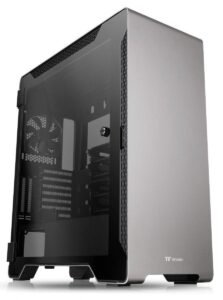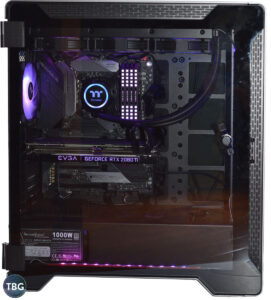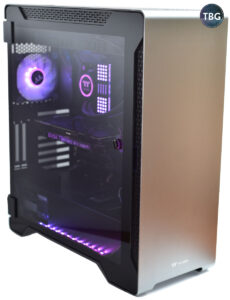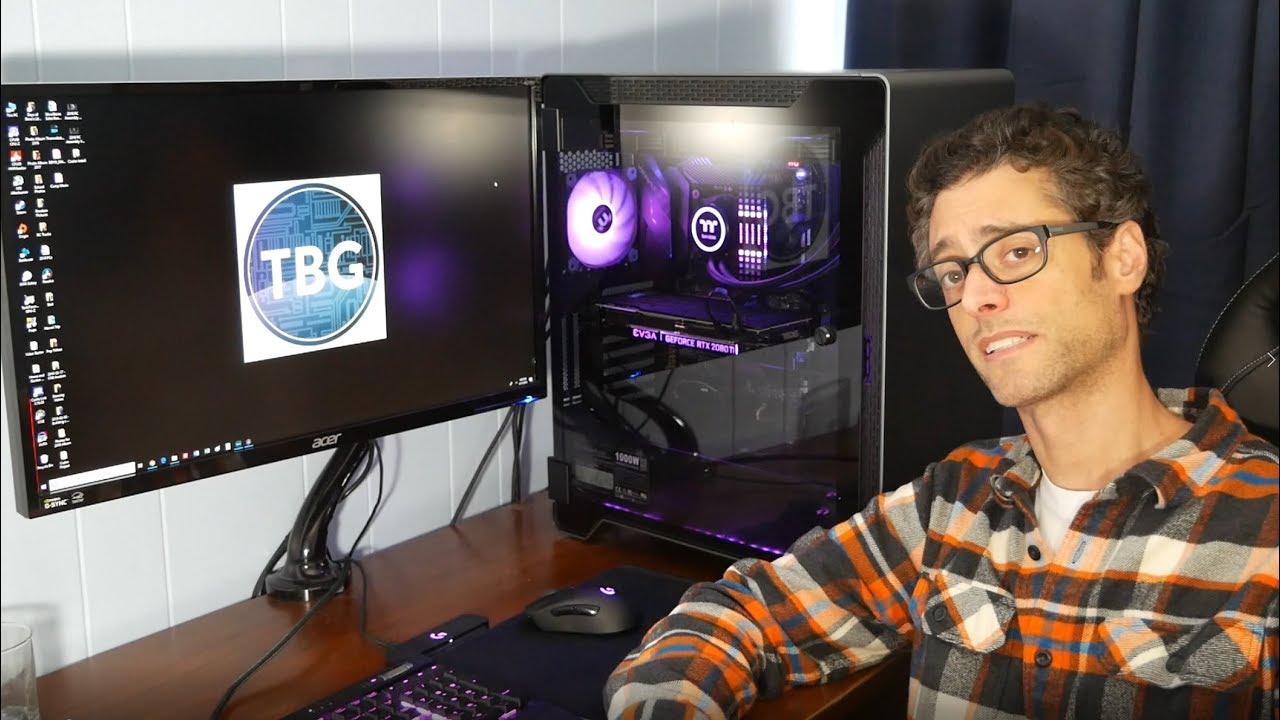Thermaltake A500 Aluminum ATX Case Review
Pros
Cons
Rating

We always start our case reviews by noting that we’ve reviewed more PC cases than any other category of product, and with this review we’re up to 25. Gluttons for punishment, perhaps, given how much time it takes to review cases, but PCs are ultimately defined by the cases they use, so it’s a pretty important product to get right! Because we’ve seen so many, we have a pretty good sense of what makes a great case, and where the rest of PC cases fall behind.
Among the most prolific PC case manufacturers over the past two decades is without a doubt Thermaltake, a company that needs no introduction among PC enthusiasts. It likely offers more PC cases than any other manufacturer, with over 250 cases currently listed on its website (seriously, we counted them!). That’s such a deep bench of products that Thermaltake pretty much has something for everyone. With that said, some of these cases are certainly a bit long in the tooth, and we’re of course most interested in the newest, most cutting-edge options available. So while we were visiting Thermaltake at CES 2019 this year, we took a hard look at what the company had on display, and decided that the case we really wanted to check out was its premium A500, released in late 2018. Thermaltake was kind enough to oblige us with not only a sample of the A500, but also its latest and greatest cooling products, so what you’ll see featured in this review is a fully “tricked-out” A500, rather than the stock out-of-the-box version.
Special thanks to Thermaltake for providing us a sample of the Thermaltake A500 Aluminum ATX Case, Water 3.0 360 ARGB Sync Cooler, and 120mm ARGB Sync Fan Kit, all featured in this review.
Description and Features
While case manufacturers have gone in a million different directions over the past few years, one thing that every high-end chassis must feature today is tempered glass. That’s just a given at this point. Acrylic windows and panels are very much a relic of a bygone past, so of course, the A500 offers tempered glass in spades: dual hinged, 4mm tempered glass panels, secured by both magnets and a metal latch. They are as slick as they come, and immediately set the A500 apart from most other tempered glass cases.
But what Themaltake is probably most proud of, and for good reason, is the curved aluminum top and front panels. Here’s how Thermaltake describes the manufacturing process:
The aluminum casing utilizes CNC milling technology and was sandblasted to help shape the elegant and sleek curves. The aluminum anodizing process enables the panels to be both water and corrosive resistant as well.
If this all sounds like pretty premium stuff, you’re right. It’s also the primary driver of the A500’s very premium price. With an MSRP of $250, it’s on the high side of expensive, and we’re betting close to 50% of the cost is sunk into those two beautiful panels. If they’re not your thing, you can probably cross the A500 off your list right now, but if you’re digging the aesthetic, read on!
Like it or not, all those premium materials inflate not jus the price tag, but the weight too: the A500 is a whopping 32.67 pounds. That is extremely heavy for a mid-tower, and its likely due to the extensive use of steel, aluminum, and glass in the A500. Plastic bits are few and far between in this chassis! Interestingly, the A500 is actually relatively compact, taking advantage of a modern layout that wastes precious little space on extraneous drive bays. At 22″ tall by 9.3″ side and 20.1″ deep, it certainly qualifies as a mid-tower, and the only dimension that is a bit on the large size is its height, due both to its elegant 2″-tall feet which allow for ample airflow underneath the chassis, along with a big roof section that easily fits liquid coolers of both the 280mm and 360mm variety, with no motherboard overlap. While its competitors are busy advertising cooler compatibility that is far less accurate, Thermaltake has clearly taken the tape measure out to ensure that its users can actually install big, powerful coolers in this chassis.
Alas, the chassis is a bit too narrow for big air coolers – the limit for this case is 160mm tall, and we did indeed confirm that our Noctua NH-U14S, which stands 165mm tall, didn’t quite fit. A pity. Owners of optical drives are similarly out of luck, but with these also being a relic that doesn’t really belong in a modern PC, we’re find with that. Luckily for users who like to horde obsolete gear, the A500 comes standard with six 3.5″ drive bays (two underneath the shroud and four in the main compartment). For our testing, we stripped them all out, which was quite easy to do thanks to the excellent modularity of the case. The only drive bay we kept was the single 2.5″ tray attached to the back of the motherboard panel. We used that for a 2.5″ SSD. If you were hoping to see a review where we fill every drive bay for the sake of posterity, we’re sorry to disappoint you, but we haven’t used a 3.5″ drive in about four years, and we don’t have any intention of every using one again!

Indeed, we like to keep our builds as modern as possible, and here’s the full build list for our A500 review:
- CPU: Intel Core i9-9900K
- Motherboard: Asus ROG Z390 Maximus XI Hero WiFi
- Video Card: EVGA GeForce RTX 2080 Ti Black 11GB
- RAM: Corsair 4x8GB Dominator Platinum RGB DDR4-3600
- Solid-State Drive #1: Samsung 970 Pro 1TB M.2
- Solid-State Drive #2: Crucial MX500 1TB 2.5″
- Power Supply: SilverStone ST1000-PTS
- CPU Cooler: Thermaltake Water 3.0 360 ARGB Sync Cooler
- Case Fans: Thermaltake 120mm ARGB Sync Fan Kit
- Light Strips: SilverStone SST-LS03 ARGB
- OS: Microsoft Windows 10 Home
By the way, we should just clarify one thing that the A500 does not have, which may come as a shock: RGB lighting! Yes, indeed, despite the fact that nearly every high-end case released in the past few years features RGB lighting, Thermaltake is clearly appealing to a different audience with the A500. With that said, we joked with Thermaltake that while the A500 may be all business in the front, that doesn’t mean there can’t be a party in the back, so our test build is decked out with more lighting than you can shake a stick at. Don’t like it? Well, the good news is that you don’t need to have it, but it does show that you can use the A500 to build a stylish, professional-looking PC that still knows how to have a bit of fun!
All right, let’s move on to a video tour of the case, and share our thoughts on the assembly process and performance.
Assembly
So, while in previous case reviews we’ve told you what it’s like to build inside a case the old-fashioned way, using words and photos, this time around we’ve compiled a complete build video, showing you everything you could possibly want to know about using the A500. In fact, this video is a full stand-alone review, so you may not need to read the rest of this article if you watch the whole thing!
Now, we’ll highlight a couple of the issues mentioned in the video that we encountered with the A500 during our testing. First, the fans are of the “cheap” variety. As much as the case materials may be premium, the three 120mm fans included with the A500 are most definitely straight out of the parts bin. They use sleeve bearings, and while they’ll certainly provide ample cooling, they won’t be as quiet as the Thermaltake ARGB fans we switched them out for, which use hydraulic bearings (and of course offer sweet lighting effects too!). The other issue with the fans is that they are mounted too low in the front of the case, which is something that is true of most Thermaltake cases. We’re not sure who decides on how to prep these cases for retail, but honestly, this is an error that doesn’t need to be repeated anymore, Thermaltake!
The other issue is one that a lot of manufacturers are struggling with right now, and that is ever-changing USB standards. The USB consortium is making the transition to USB 3.0 and Type-C about as hard as possible, and unfortunately, Thermaltake seems to have gotten caught in the trap with the A500. In addition to two old-school USB 2.0 ports, it features two USB 3.0 Type-A ports up top, along with a USB Type-C port, which unfortunately uses a USB 3.0 internal connector. The issue here is that while this would have been OK in late-2017, when most high-end motherboards were transitioning to including dual USB 3.0 headers, it’s not OK in 2019. With USB Type-C catching on, board manufacturers have switched again, with most high-end boards now including just one USB 3.0 header and one USB 3.1 Type-C header. That means that in order to use all the front ports on the A500, you’re almost guaranteed to need an adapter. We used this USB 3.0 to 3.1 adapter, which is limited to 3.0 speed, but at least let us use our Type-C port! We think Thermaltake should seriously consider including an adapter going forward, as it’s otherwise going to hear a lot of howling from disgruntled customers.
Performance

Because we used a brand-new platform for this test, we can’t directly compare the thermal performance of the A500 to previous cases. The Core i9-9900K is a far hotter CPU than we’ve ever used before, and the RTX 2080 Ti video card has a far more power-hungry GPU than any previous card we’ve tested. With that said, we can say this: the A500 performed extremely well in our testing. While it obviously has an airflow-blocking solid front fascia, unlike many other cases that ascribe to this popular design aesthetic, the A500 actually overcomes the inherent thermal challenge by providing ample side vents that are not blocked by the intake fans themselves. Thermaltake also designed in totally functional top vents, which again are a step beyond the vents in many other cases we’ve tested. Too often, manufacturers install a solid panel up top and then punch a couple of vents here and there for exhaust, but this ends up being more for aesthetics than anything else. Thermaltake does it for real, not for show.
The end result was that our GeForce RTX 2080 Ti never topped 80 °C in our testing, which is quite impressive given its power consumption. Similarly, our Core i9-9900K, which was overclocked to 5GHz and cooled by the ample Thermaltake Water 3.0 360mm liquid cooler, typically sat around 60 °C during gaming and hit a maximum of 77 °C during a Cinebench test. This was all while the A500 kept noise at bay, making for a very fine balance of looks, thermals, and acoustics. You can find cases that will beat the A500 in one or perhaps two of these categories, but it’s going to be hard to find a case that offers the dialed combination that the A500 provides.
Conclusion
There’s just no other way to put this: the Thermaltake A500 is among the best high-end cases on the market. It uses ultra-premium materials, offers fantastic modularity, and just looks sweet. In order to hit the $250 pricepoint, Thermaltake did cut a few corners when it comes to fans and USB ports, but we’re going to give them a pass on those issues. It’s the big things that count, and Thermaltake got virtually everything else right with the A500. We love the aesthetics, from the sweet hinged glass doors that provide easy access and look good doing it, to the sand-blasted aluminum panels, which flow smoothly from the bottom of the feet all the way to the top rear edge of the chassis. We also love the performance: the A500 provides a great combination of low noise, ample airflow, and most importantly in our book, perfect compatibility with ultra-high-end liquid cooling solutions. That might seem like a given that Thermaltake is one of the biggest manufacturers of high-end cooling equipment, but you’d be surprised at how many of its main competitors in the case and cooling market get this wrong over and over again.
The Thermaltake A500 Aluminum ATX Case is available for $234.99 shipped free from Amazon as of our publication date. To see all of our recommended cases, simply browse TBG’s PC Buyer’s Guides, which highlight our top 24 favorite cases on the market!


